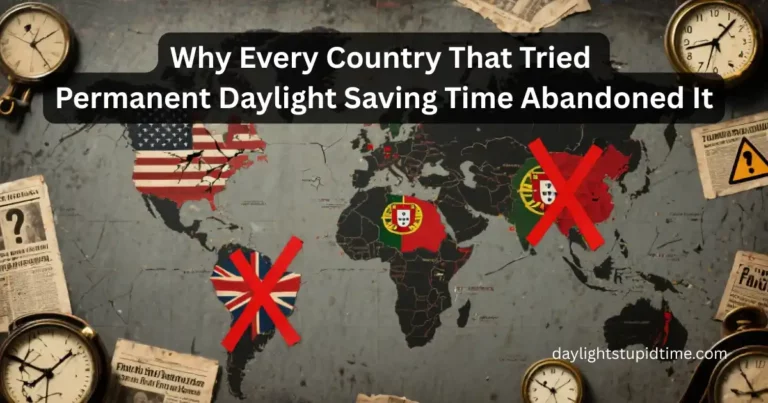The Economic Disaster Hidden in the Sunshine Protection Act
The Economic Disaster Hidden in the Sunshine Protection Act: Why Permanent DST Could Cost America Billions
While proponents of the Sunshine Protection Act tout economic benefits, rigorous economic analysis reveals a disturbing truth: permanent daylight saving time could trigger one of the most expensive policy disasters in modern American history. The hidden costs extend far beyond the often-cited $434 million in annual economic losses, reaching into workplace safety, healthcare systems, and long-term productivity across virtually every sector of the economy.
The $411 Billion Sleep Crisis
The foundation of the economic argument against permanent daylight saving time lies in its devastating impact on sleep quality across the American workforce. Current research estimates that chronic sleep deprivation already costs the United States $411 billion annually in lost productivity and healthcare costs. Permanent daylight saving time would dramatically worsen this crisis by forcing the entire population into a state of chronic circadian misalignment.
Dr. Matthew Gibson and Dr. Jeffrey Shrader’s groundbreaking research on sleep and wages provides crucial insights into these economic impacts. Their study found that a one-hour increase in average weekly sleep increases wages by 1.5% in the short run and by 4.9% in the long run. Conversely, the sleep disruption caused by permanent DST would reverse these gains, creating a massive drag on economic growth.
The mechanism is straightforward: when workers are chronically sleep-deprived due to circadian disruption, their cognitive performance, decision-making abilities, and physical stamina all decline significantly. This translates directly into measurable economic losses across multiple dimensions.
Workplace Accidents: The Hidden Tax on Business
One of the most immediate and costly impacts of permanent daylight saving time would be the dramatic increase in workplace accidents and injuries. Research consistently shows that the spring transition to daylight saving time is associated with:
- Increased workplace injuries in the days following the time change
- Higher rates of “Monday effect” accidents due to disrupted weekend sleep
- Decreased attention and reaction times among workers
- Impaired decision-making in safety-critical situations
The economic implications are staggering. According to the Bureau of Labor Statistics, workplace injuries cost American employers over $170 billion annually in direct and indirect costs. The chronic sleep disruption caused by permanent DST could increase these costs by 10-15%, adding tens of billions in preventable expenses.
Manufacturing, construction, healthcare, and transportation industries would bear the heaviest burden. These sectors rely heavily on alertness, precision, and quick reflexes – all of which are severely compromised by circadian disruption and sleep deprivation.
The Healthcare Cost Explosion
The healthcare system would face an unprecedented burden under permanent daylight saving time. The University of Connecticut’s research showing a 27% increase in heart attacks during DST transitions provides a glimpse into the potential catastrophe. If this effect becomes permanent and year-round, the healthcare costs would be astronomical.
Consider the economic impact of just the cardiovascular effects:
- Average cost of heart attack treatment: $53,000-$78,000
- Potential increase in annual heart attacks: 50,000-75,000
- Direct healthcare costs: $2.7-$5.9 billion annually
- Lost productivity from cardiovascular events: $8-12 billion annually
This doesn’t include the costs associated with increased depression, anxiety, sleep disorders, and other health conditions linked to circadian disruption. The total healthcare cost increase could easily exceed $20 billion annually.
The Productivity Paradox
Proponents often argue that permanent daylight saving time would boost productivity by providing more daylight for evening activities. However, economic research tells a different story. The supposed productivity gains from extended evening daylight are completely overwhelmed by the massive productivity losses from chronic sleep deprivation and circadian disruption.
Studies of the current DST transitions show measurable decreases in:
- Stock market performance on “Monday after” effects
- Cognitive test scores among students
- Work output in knowledge-intensive industries
- Creative problem-solving abilities
- Teamwork and collaboration effectiveness
A comprehensive analysis by Chmura Economics & Analytics found that the negative economic impacts of DST far outweigh any potential benefits, with the twice-yearly transitions alone costing the economy hundreds of millions annually. Making this disruption permanent would multiply these costs exponentially.
The School Performance Crisis
The economic implications extend into education, where permanent daylight saving time would create a generation of chronically sleep-deprived students. Research shows that later school start times (which align better with natural circadian rhythms) could add $8.6 billion to the economy within two years through increased graduation rates and improved educational outcomes.
Permanent DST would reverse these gains by:
- Forcing students to wake up during their biological night
- Increasing absenteeism and dropout rates
- Reducing standardized test scores
- Impairing long-term academic achievement
- Decreasing future earning potential for an entire generation
The Energy Efficiency Myth
One of the most persistent myths about daylight saving time is that it saves energy. Modern economic analysis has thoroughly debunked this claim. In fact, permanent daylight saving time would likely increase energy consumption due to:
- Greater use of air conditioning during extended evening daylight
- Increased travel and recreational activities consuming fuel
- Higher electricity demand during peak evening hours
- Inefficient heating patterns during dark winter mornings
The Indiana experience, studied extensively by economists, showed that adoption of daylight saving time actually increased energy consumption and costs for consumers.
International Economic Lessons
The economic failures of permanent daylight saving time aren’t theoretical – they’re demonstrated by real-world experiences. Russia implemented permanent DST in 2011 but reversed course in 2014 due to economic disruption and public dissatisfaction. The United Kingdom tried it from 1968-1971 and Portugal from 1992-1996, with both countries abandoning the policy due to negative economic and social impacts.
The Path to Economic Recovery
The economic evidence is overwhelming: permanent standard time, not permanent daylight saving time, offers the best path forward for American economic prosperity. By aligning our clocks with natural circadian rhythms, we can:
- Reduce healthcare costs by billions annually
- Increase workplace productivity and safety
- Improve educational outcomes and future earning potential
- Maintain energy efficiency and reduce consumption
- Support worker health and well-being
The Sunshine Protection Act may promise economic benefits, but the hard data reveals an economic disaster in disguise. Congress must reject this costly mistake and instead pursue policies that support American workers, businesses, and economic growth through the scientifically-proven benefits of permanent standard time.


